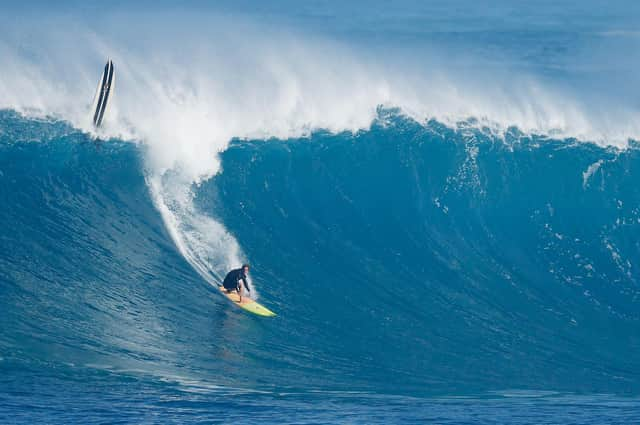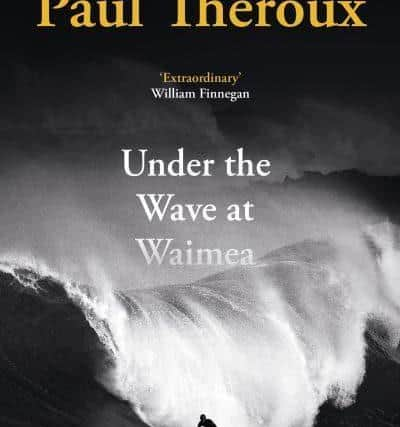Book review: Under the Wave at Waimea, by Paul Theroux


Perhaps the most cliched piece of advice offered to wannabe novelists is "write about what you know." Just because it's a cliche, however, doesn't make it wrong. If Hemingway hadn't been such a keen fisherman, chances are The Old Man and the Sea would have ended up as a dull, repetitive yarn about an elderly bloke in a boat. Then again, is it theoretically possible that he could have written the same story if he'd never fished a day in his life? Well, yes, assuming he had access to enough fishing magazines and carried out a few research trips to Cuba. So maybe a better piece of advice than "write about what you know" is "know about what you write," which brings us to veteran travel writer and author Paul Theroux, now 80, and his new novel, Under the Wave at Waimea.
As the name implies, this is a story about surfing, and it is largely set on the Hawaiian island of Oahu, where the titular big wave surf spot is located. The protagonist is Joe Sharkey, a 62-year-old surfer, famous for his exploits in giant surf, who now lives an idyllic if largely unexamined life in a house close to Waimea with his new-ish and much younger English girlfriend, Olive, a no-nonsense A&E nurse. He surfs, eats, sleeps, has sex, smokes pakalolo and talks story with his old surfing buddies. Occasionally he seems a little perturbed by the fact that some younger surfers don’t seem to know or care who he is or how many enormous waves he’s ridden, but these moments of mild displeasure are never enough to harsh his buzz.
Advertisement
Hide AdHis buzz does get seriously harshed one rainy night, however, when he hits a man on a bike while driving home from a bar with Olive. As Sharkey sees it, he’s simply “killed a drunk homeless guy” and the police don’t seem too bothered about the dead man either, or about the fact that Sharkey had been drinking. After the accident, though, Sharkey’s charmed existence starts to crumble, and Olive becomes convinced that the only way for him to get his life back on track is find out more about the man he killed, as a means of coming to terms with what he has done.


In many respects, it’s a set-up that allows Theroux to write about what he knows: for some years now, he’s divided his time between Cape Cod and Hawaii, so he’s familiar with the islands; and, while he isn’t a surfer, he is an experienced kayaker (Exhibit A: his 2006 book The Happy Isles of Oceania: Paddling the Pacific), so he is familiar with the ocean, if not necessarily with the dynamics of breaking waves.
At the core of Under the Wave at Waimea, however, is surfing, and evidently this is not a subject Theroux properly understood before, during or after writing the novel. As the surf journalist Matt Warshaw has pointed out, in a review based on only a partial reading of the book, “The fault here is not that Theroux is an outsider. That’s fine. Some of the best takes on the sport have been made by outsiders. But the writer has to care enough, be interested enough, to make something previously unknown to him or her come to life.”
Writers who care about a subject typically obsess over the details, but it’s here that Theroux falls short, to the extent that – certainly for any surfers reading – the constant glitches will prove hair-tearingly distracting. Even the tiniest errors grate. At one point, Sharkey claims to have owned one of Miki Dora’s “long boards” as opposed to one of his longboards; elsewhere Theroux mentions a surfer "whose board had dinged the rock" but in surf-speak rocks tend to ding boards, not the other way around; and there’s a reference to Sharkey surfing “Mentawai Reef” – the Mentawai Islands boast a plethora of reefbreaks, but talking about surfing "Mentawai Reef" is about as precise as saying “surfing Hawaii Reef.”
It’s the errors that show a lack of understanding of the actual act of surfing, though, which really jar. When one of the Hawaiian kids at Sharkey’s school sees Sharkey’s first surfboard he says “Put some sex wax on dis and it fly.” Problem one: by “sex wax” the author presumably means Sex Wax – a brand of surf wax. Problem two: surf wax goes on the deck of a board to give grip underfoot, not on the bottom, as with skis, to make it go faster, so no amount of Sex Wax would make a board “fly,” no matter which surface you applied it to. Similarly, during a wipeout Sharkey is “dragged down until he reached and slipped the leash over his foot” but leashes are attached by means of a velcro cuff. In the event that you were able to get your hand anywhere near your ankle while being tumbled around underwater during a serious, big wave wipeout, you wouldn’t “slip” your leash off, you’d grab the tab on the velcro and yank it hard. (There’s also a question mark over why a surfer in this situation would want to detach himself from his surfboard in the first place – a flotation device that could well save his life. Occasionally surfers have been held underwater after their boards or leashes have become wedged into cracks in a reef, but there’s no suggestion that this is the case here. The first thing most surfers do after a wipeout is use their leash to help them get back to their board.)
I could go on – and I suspect that, were he ever to finish reading the book, Warshaw, a revered surfing historian, would have a few things to say about its chronology. Out of the water, Sharkey’s laborious journey towards enlightenment does have its moments, but without a convincing aquatic core the story feels about as authentic as plastic leis.
Advertisement
Hide AdUnder the Wave at Waimea, by Paul Theroux, Hamish Hamilton, £18.99
A message from the Editor:
Thank you for reading this article. We're more reliant on your support than ever as the shift in consumer habits brought about by coronavirus impacts our advertisers.
If you haven't already, please consider supporting our trusted, fact-checked journalism by taking out a digital subscription at https://www.scotsman.com/subscriptions